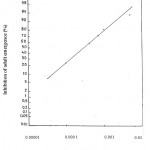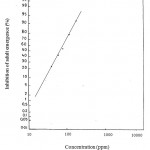Manuscript accepted on : September 09, 2009
Published online on: 28-12-2009
Kh. M. S. Al-Ghamdi1, M. S. Saleh2, J. A. Mahyoub1 And Z. I. Al-Fifi1
1Department of Biological Sciences, Faculty of Science, King Abdul-Aziz University, Jeddah KSA.
2Mosquito Research Lab., Jeddah Kigndom of Saudi Arabia.
ABSTRACT: The biological effects of the insect growth regulator (IGR) , Dudim and the plant extract Neem oil on the developmental stages of Culex pipiens, the dominant mosquito species in Jeddah,Saudi Arabia, were evaluated. The records showed that the response of Cx. pipiens to the test compounds depends on the differential mode of action of the compounds and its effective concentrations. According to IC50 values (concentration which to inhibit the emergence of 50% of mosquito adults emergence), the IGR Dudim (0.0003 ppm) proved to be more effective against Cx. pipiens than the Neem oil (70 ppm). On the other hands, treatment whit IC90 values (concentration which to inhibit the emergence of 90% of mosquito adults emergence) of Dudim (0.0032 ppm) and Neem oil (140 ppm) did not exhibit any market effect on nontarget organisms (naiads Odonata, aquatic hemipterans, aquatic coleopterans) associated with mosquito breeding sites.
KEYWORDS: Insect growth regulator; Culex pipiens; neem oil; aquatic organisms
Download this article as:| Copy the following to cite this article: Al-Ghamdi. K. M. S, Saleh. M. S, Mahyoub. J. A, Al-Fifi. Z. I. Laboratory Evaluation Of The Insect Growth Regulator Dudim And The Plant Extract Neem Oil Against Culex Pipiens Mosquitoes With Reference to its Side Effects on Aquatic Nontarget Organisms. Biosci Biotechnol Res Asia 2009;6(2) |
| Copy the following to cite this URL: Al-Ghamdi. K. M. S, Saleh. M. S, Mahyoub. J. A, Al-Fifi. Z. I. Laboratory Evaluation Of The Insect Growth Regulator Dudim And The Plant Extract Neem Oil Against Culex Pipiens Mosquitoes With Reference to its Side Effects on Aquatic Nontarget Organisms. Biosci Biotechnol Res Asia 2009;6(2). Available from: https://www.biotech-asia.org/?p=8647 |
Introduction
With increasing problems of environmental pollution by chemical insecticides and development of resistance in many species of mosquito vectors, intensive work was currently paid to the use of non-conventional insecticides as insect growth regulator (IGR) and plant extracts for mosquito control in different parts of the world (Saleh and wright,1989; Chowdhury et al.,2007; Seng et al.,2008).
The present work was planned in part to evaluate the biological effects of two non-conventional insecticides, (IGR) , Dudim and the plant extract Neem oil, against Cx. pipiens, the dominant mosquito species in Jeddah,Saudi Arabia. Additional test were also conducted to study the side effects of the test compounds on some nontarget organisms associated with mosquito habitats.
Material and methods
Mosquito strain
Tests were performed on a field strain of Cx. pipiens raised from wild larvae, collected from Jeddah governorate, Saudi Arabia, and had been maintained in the laboratory under controlled conditions of 27± 1 oC and 70 ± 5% R.H, with a 14 : 10 (L :D) photoperiod.
Compounds tested
Two non-conventional insecticides were used:
The insect growth regulator Dudim (4G%); 1-(4-chlorophenyl)-3-(2,6-difluorbenzoyl)-urea, kindly supplied by Dr. KH. Al. Ghamdi, Fac. of science, King Abdulaziz Univ.
The plant extract Neem oil (Azadirachtain indica) kindly supplied by Dr. M. A. Khan, Dept. of Zoology, Saifia Science College Bhopal, India. The stock solution of the plant extract was prepared by adding 1 ml of it to 99 ml of distilled water containing 0.5% triton X-100 as an emulsifier to ensure complete solubility of the extract in water. Series of concentrations were prepared in distilled water.
Test experiments
The Larval susceptibility test was conducted according to the method of WHO (1981). Treatments were carried out by exposing early 4th instar larvae of Cx. pipiens to various concentrations of the tested compounds in groups of glass beakers containing 100ml of tap water. Five replicates of 20 Larvae each per concentration , and so for control trials were set up. The Larvae were given the usual larval food during the experiments. Mortalities of larvae and pupae were recorded daily. The percentage of inhibition of adult formation was recorded and compared with those of the controls under the same conditions of tests ( Abbott,1925). Log concentration – probability regression lines were drawn for the tested compounds and statistical parameters were also calculated using the method of Litchfield and Wilcoxon (1949).
Additional tests were also conducted to study the side effects of the IGR Dudim and the plant extract Neem oil on some aquatic nontarget organisms associated with mosquito breeding habitats. The test organisms were collected form a pond water known to be mosquito breeding sites. The nontarget organisms were Odonata naiads, aquatic bugs ( Order : Hemiptera) and aquatic beetles (Order: Coleoptera).
The concentrations corresponding to IC90 values (concentration which to inhibit the emergence of 90% of mosquito adults emergence) were drived form the toxicity lines of Dudim and Neem oil. These concentrations were prepared and chosen for treating the aquatic organisms. Treatments were carried out by exposing the individuals to the test concentrations in 500 ml glass beakers with 100 ml of tap water. Three replicates of 4 individuals each per concentration, and so for control were set up. Mortalities were recorded after 24hr post-treatment.
Results and Discussion
Percentage mortalities of Cx. pipiens larvae and inhibition of adult emergence following treatments with the IGR Dudim and the plant extract Neem oil are shown in table 1. In general, 2-30% and 11-65% larval mortalities were obtained when 4th instar larvae of Cx. pipiens were treated with the effective concentrations of the above compounds, respectively. This means that the test compounds did not appear to give high percentages of mortality against larval stages. In other words, the results thus may confirm the unsuitability of larval mortality records as a measurement for evaluating the efficacy of such compounds (saleh,1985).
The biological effects of the present compounds were often manifested by the formation of a type of larval – pupal intermediate. Moreover, most pupae were died before the adult emerged. Some adults emerged incompletely or left their tarsi attached in the pupal exuvia (Al-sharook et al.,1991). Therefore, the biological effects of Dudim and Neem oil were expressed as the percentage of larvae that do not develop into successfully emerging adults or the inhibition of adult emergence (WHO,2005).
Generally, the effective concentrations of Dudim and Neem oil in respect were 0.0001-0.005 ppm and 40-150 ppm. The corresponding percentages of inhibition of adult emergence were 22.5 – 94.6% and 23.4 -92.5%, respectively. According to IC50 values (concentration which to inhibit the emergence of 50% of mosquito adults emergence), the IGR Dudim (0.0003 ppm) proved to be more effective against Cx. pipiens mosquitoes than the plant extract Neem oil (70 ppm). It can be concluded that the response of Cx. pipiens to the test compounds depends entirely on the differential mode of action of these compounds and its effective concentrations. Studies in this respect were carried out by other investigators using the IGR cyromazine against Cx. pipiens and Aedes epacticus (Saleh and wright,1989); the IGR methoprene against Ae. nigromaculis (Cornel et al., 2000) and the plant extract Solanum villosum against Cx. quinquefasciatus (Chowdhury et al.,2007). However, consideration must be taken to study the effect of environmental conditions on the effectiveness of such compounds when applied for field control measures.
On the other hand, the side effect of the IGR Dudim and the plant extract Neem oil on three nontarget organisms viz. Odonata naiads, aquatic bugs (Order: Hemiptera) and aquatic beetles (Order: Coleoptera) was evaluated in the laboratory. In general, the records indicated that treatment with the concentrations corresponding to IC90 values of Dudim (0.0032ppm , Fig.1) and Neem oil (70ppm , Fig.2) did not exhibit any marked effect on the test nontarget organisms. Similar findings have been obtained by Miura and Takahashi (1975) who found that treatment with the IGR TH6040, at rates used for mosquito control, did not have any adverse effects against aquatic beetles and spiders associated with mosquito larvae in the pond water. Gunasekaran et al.(2004) reported that treatment with the sub-lethal doses of the bioinsecticide Teknar HP-D did not affect on Gambusia fish and water bugs of Notonecta sp. and Diplonychus indicus. Moreover, treatments with the IGR pyriproxyfen (sumilarv) against mosquito larvae did not have any impact on aquatic hemipterans ( Vythilingam et al., 2005).
 |
Figure 1: The relation between concentrations of Dudim and the percentage of inhibition of adult emergence after treatment of Cx. pipiens larvae.
|
 |
Figure 2 : The relation between concentrations of Neem oil and the percentage of inhibition of adult emergence after treatment of Cx. pipiens larvae.
|
Generally, it can be concluded that the present IGR Dudim and the plant extract Neem oil seem to have a good margin of safty to aquatic natural enemies prevailing in mosquito breeding habitats. Therefore, the use of such non-conventional compounds in mosquito control programs offers certain advantages over some currently used chemical insecticides.
Table 1: The percentage inhibition of adult emergence following treatment of Cx. pipiens mosquito larvae with the IGR Dudim and the plant extract Neem oil.
| Compound | Effective
concentrations (ppm) |
larval a
mortality (%) |
Inhibition
of adult emergence b (%) |
Statistical parameters c | ||
| IC50 | IC90 | Slop | ||||
| Dudim
Control |
0.0001- 0.005 | 2 – 30
4 |
22.5 – 94.6
7 |
0.0003 | 0.0032 | 1.54 |
| Neem oil
Control |
40 – 150 | 11 – 65
3 |
23.4 – 92.5
6 |
70 | 140 | 3.6 |
a: Five replicates, 20 larvae each
b: Corrected by Abbotts formula (Abbott, 1925)
c: Litchfield and Wilcoxon (1949)
References
- Abbott, W.S. (1925). A method of computing the effectivenss of an insecticide. J. Econ. Entomol. 18: 256 – 269 .
- Al-Sharook, Z.;K. Balan; Y. Jianhg and H. Rembold (1991). Insect growth inhibitors from two tropical Meliaceae effect of crude seed extracts on mosquito larvae. J. Appl. Ent. 111, 425-430.
- Chowdhury, N.; S. Laskar; G. and Chandra (2007). Efficacy of Solanum villosum Mill. (Solanaceae: Solanales) as biocontrol agent against fourth instar larvae of Culex quinquefasciatus Say. Turk J Zool.; 31:365–370.
- Cornel, A. J.; M. A. Stanich; D. Farley; F. S. Mulligan and G. Byde (2000). Methoprene tolerance in Aedes nigromaculis in Fresno country, California. J. Am. Mosq. Control Assoc., 16 (3): 223-228.
- Gunasekaran, K; P. S.Boopathi Doss and K. Vaidyanathan(2004). Laboratory and field evaluation of Teknar HP- D, a biolarvicidal formulation of Bacillus thuringiensis against mosquito vectors. Acta. Tropica. 109-118.
- Litchfield, J. T. and E. Wilcoxon (1949). A simplified method of evaluating dose-effect experiments. J. Phar. Exp. Ther. 96, 99 -113.
- Miura, T. and R.M. Takahashi (1975). Effects of the IGRs TH6040 on nontarget organisms when utilized as a mosquito control agent. Mosq. News. 35: 154-159.
- Saleh, M. S. (1985) Effects of six insect growth regulators on mosquito
- larvae of Aedes aegypti Insect Sci. Application ., 6: 609- 611.
- Saleh , M.S. and R.E. Wright (1989). Effects of the IGR cyromazine and the pathogen Bacillus thuringiensis israelensis on the mosquito Aedes epaticus. J. Apple Entomol ., 108 : 381 – 385
- Seng, C. M.; T. Setha; , J. Nealon; D.SSocheat and M. B. Nathan(2008). Six month of Aedes aegypti control with a novel controlled- release formulations of pyriproxyfen in domestic water storage containers in Combodia. South. Asian J. Trop. Med. Pub. Heath. 39(5): 822-826.
- Vythilingam, I.; P.M. Luz; R. Hanni; T. S. Beng and T. C. Huat (2005). Laboratory and field evaluation of the insect growth regulator Pyriproxyfen (Sumilarv 5 G) against Dengue vectors. J. Am. Mosq. Cont. Assoc. 21(3): 296-300.
- World Health Organization (1981).Instructions for determining the susceptibility or resistance of mosquito larvae to insecticides . WHO/VBC/81.807:1-6
- WHO (2005).Guidelines for laboratory and field testing of mosquito larvicides .WHO/CDS/WHOPES/CDPP/13.

This work is licensed under a Creative Commons Attribution 4.0 International License.





